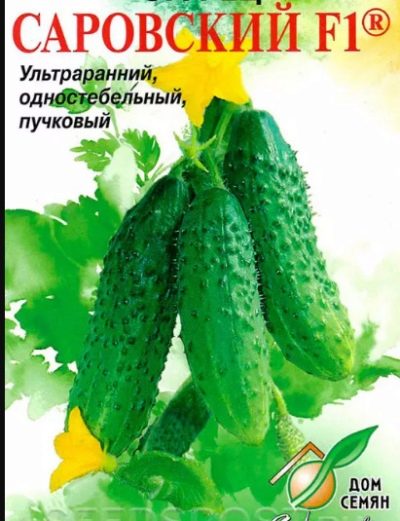
- Authors: Ivanova T.E., Vasiliev Yu.V.
- Year of approval: 2007
- Growth type: vigorous, indeterminate
- Branching: limited
- Fruit weight, g: 85-110
- Fruit length, cm: 11-13
- Fruit color: dark green
- Ripening terms: early
- Fruit shape: cylindrical
- Fruit taste: good, no bitterness
The Sarovsky hybrid is perfect for lovers of small crispy cucumbers. The variety is early maturing, productive and picky to care for.
Description of the variety
Sarovsky is a hybrid of domestic breeding, popular since 2007. Parthenocarpic variety is perfect for open ground and for temporary shelters. It is grown almost throughout the country.
Characteristics of the appearance of plants and zelents
The main stem has an indeterminate growth. The bushes grow quite high, their height is about 3 m. The flowering of such cucumbers is predominantly female, the fruiting is bouquet. From 3 to 8 ovaries develop in a bunch.
The fruits are rather short, have a regular cylindrical shape and a dark green color. The skin is thin, sweet, there are large tubercles on which white thorns are neatly located. Fruit weight can range from 85 to 110 grams. Fruit length - 11-13 cm.
Purpose and taste of fruits
The fruits taste more than good, their seeds are soft, they are not felt. The pulp is juicy, firm and crunchy. You can use such fruits in absolutely any form: raw, canned, and they are also great for pickling. You can store cucumbers for 2-3 weeks at a temperature of +4 degrees. It is also worth noting that cucumbers tolerate transportation calmly.
Maturation
As a rule, ripening occurs within 38-42 days after planting the plant in the soil.
Yield
The variety has a good yield. In a film greenhouse, the yield reaches 15.5 kg per square meter, while in open ground the result is several times less - 6.6 kg per square meter. In total, from 18 to 20 kg of cucumbers can be harvested per season.
Growing and care
Cultivation is done in two ways: seedlings and direct planting of seeds into the soil.
When breeding seedlings, seeds are sown in pots or hotbeds in the last decade of April - early May, and a little later, in early June, the plants are planted in the beds. It is necessary that the rows are about 50 cm wide, the depth should be 4 cm. For seedlings of cucumbers you need a container, if you do not have one, you can take plastic cups. The land can be either purchased in the store or taken from the garden.
If you are planting seeds, this should be done between May and June, when the soil is warm enough. The planting pattern remains the same, only the depth is shallower: it should be 2 cm. Store seeds do not need to be processed.
As for leaving, Sarovsky is picky and does not need special attention. It is only important to water the plant abundantly every day, fertilize and loosen the soil for oxygen enrichment of the roots. It is also necessary to remove weeds in a timely manner in order to protect the plant from their harm.
Soil requirements
This variety requires a light soil with medium acidity. The place is best prepared in the fall. A plus will be a sunny area with little shading in order to protect the plant from active ultraviolet radiation.
At the beginning of autumn, the soil must be ennobled by introducing organic fertilizers (approximately 10 liters of manure per 1 square meter).If this type of fertilizer is not available, you can use a mineral fertilizer, for example, potassium salt or superphosphate. Before planting, the earth is re-dug up and fertilized with saltpeter - 20 grams per 1 square meter.
When sowing seeds from May to June, it is advisable to cover the crops with foil at night.

In order to collect strong, tasty and beautiful cucumbers on your site, you need to make top dressing. Lack of nutrients can negatively affect the appearance of the plant and significantly reduce the yield. Fertilize cucumbers with organic fertilizers in combination with mineral fertilizers. With the right balance of these components and adherence to the fertilizing schedule, the cucumber yield will be maximum.
Required climatic conditions
The Sarovsky variety feels most relaxed in regions with a temperate climate. However, it has good indicators of heat resistance and cold resistance, therefore, in general, gardeners of any region can be engaged in its cultivation.

Despite their popularity, cucumbers are often attacked by diseases and pests. From them, cucumber plantings often die before the start of fruiting. In order to prevent this from happening, it is necessary to try to prevent ailments or get rid of them at the very beginning, having studied in detail their causes of occurrence, signs and methods of treatment.





























































































